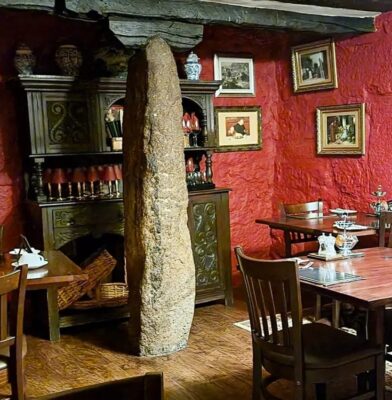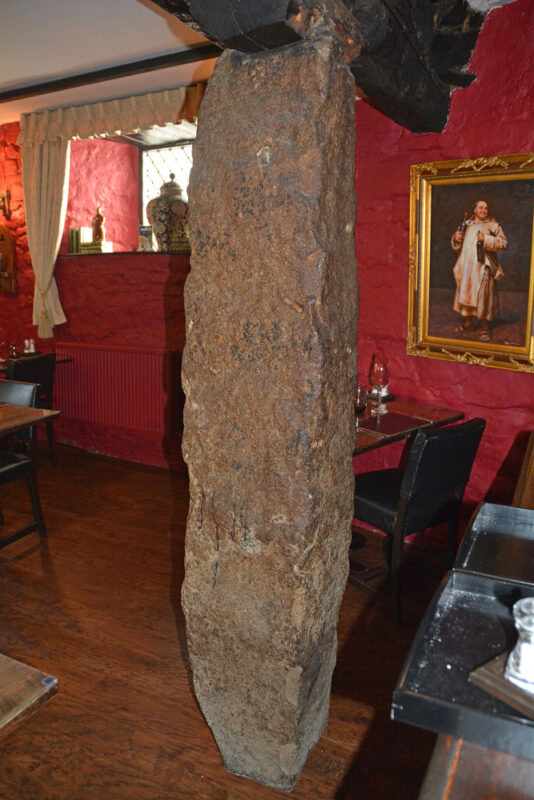The Ancient Standing Stone Located in the picturesque Dartmoor, UK, a remarkable 27-foot granite standing stone dates back over 5000 years to the Neolithic period. This ancient monument has stood the test of time and now resides uniquely within The Oxenham Arms pub, a building constructed around the stone 800 years ago. A blend of history and modernity, this site offers a captivating glimpse into Dartmoor’s rich past. Follow archeology.dulichvn.net to discover many hidden mysteries that have yet to be discovered.

The Ancient Standing Stone at The Oxenham Arms: A Timeless Monument
Origins from 5000 Years Ago
The standing stone was erected during the Neolithic period, a time when communities began to transition to farming and established more permanent settlements. This 27-foot-high granite marvel is believed to have held ceremonial or spiritual significance for the ancient people of Dartmoor.
Preserving a Historical Wonder
Despite the passage of millennia, this towering granite monument remains in its original location, showcasing the durability of Neolithic craftsmanship and their profound connection to the land.
A Symbol of Early Human Innovation
The stone not only marks a physical presence but also serves as a testament to the ingenuity and determination of ancient societies that moved and positioned such massive structures without modern machinery.

The Oxenham Arms: A Pub Built Around History
A Medieval Structure with Ancient Roots
Constructed around 800 years ago, The Oxenham Arms incorporates the standing stone into its very foundations. This pub is a unique blend of medieval architecture and Neolithic history, making it a must-visit location for history enthusiasts.
The Standing Stone in the Cellar
The granite monolith extends deep into the cellar of the pub, anchoring both the building and its historical legacy. Visitors can explore this feature and witness how seamlessly the ancient and medieval eras coexist.
A Landmark of Dartmoor’s Heritage
The Oxenham Arms is more than just a pub; it’s a living museum, preserving a piece of Dartmoor’s prehistoric heritage while serving as a community hub for centuries.

The Fascination of History Meeting Modernity
An Iconic Tourist Attraction
Today, the standing stone and The Oxenham Arms attract visitors from all over the world, offering an unparalleled opportunity to experience a slice of history that spans thousands of years.
The Spiritual Connection
For some, the standing stone represents more than just an artifact; it’s a link to ancient spirituality and the rituals of Neolithic societies.
A Testament to Endurance
The enduring presence of the stone, from prehistoric times through medieval construction and into the present day, is a powerful reminder of human history’s depth and resilience.

Why Visit The Oxenham Arms?
Explore the Stone’s Legacy
Discover the story of how this Neolithic monument became an integral part of a medieval pub, offering a unique perspective on the merging of different historical periods.
A Step Back in Time
Walking into The Oxenham Arms is like stepping back in time, with the ancient stone serving as the centerpiece of an immersive historical experience.
A Hidden Gem in Dartmoor
Nestled in the stunning Dartmoor landscape, The Oxenham Arms and its ancient stone provide an unforgettable destination for history buffs and casual travelers alike.
See more: The Mummy of Pharaoh Amenhotep’s Beloved Dog: A 3,500-Year-Old Relic
Conclusion: Where History Stands Tall
The standing stone at The Oxenham Arms is a true marvel, embodying 5000 years of history. From its Neolithic origins to its role as a foundation for a medieval pub, it tells a story of resilience and significance. Visiting this site is not just a journey through Dartmoor but a journey through time itself, making it an unmissable experience for anyone with a passion for the past.


CÁC TIN KHÁC
Mark Twain & Olivia Langdon: A 36-Year Love Story Filled with Laughter and Devotion
The Tollund Man: A 2,400-Year-Old Mystery Preserved in a Danish Bog
Skara Brae: Scotland’s Hidden Neolithic Village
Porta Nigra: The Hidden Depths of Trier’s Iconic Roman Gate